Here’s Dewey Caron’s April 2017 presentation to the club.
To participate in the survey, please visit PNWHoneyBeeSurvey.com.
Dewey also provided us an excellent document on Dead Colony Forensics.
Here’s Dewey Caron’s April 2017 presentation to the club.
To participate in the survey, please visit PNWHoneyBeeSurvey.com.
Dewey also provided us an excellent document on Dead Colony Forensics.
In this month’s Beeline we will be recapping our February 1st PUB meeting.
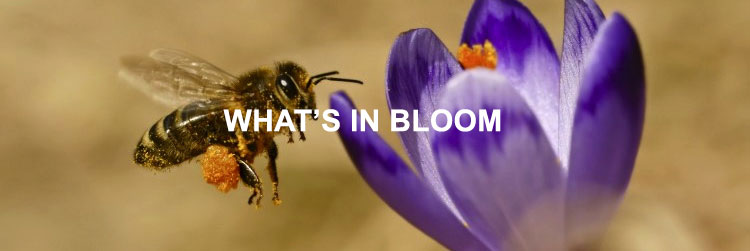 Once again, Bridgetown Bees‘ Glen Andresen shared his monthly Pollen & Nectar report with his extensive slideshow on current flowering plants. Even though we’re coming out of an atypically harsh winter, Glen provided some great information on the several blooming nectar and pollen plants just coming into bloom that are keeping our girls busy this February and March. You may want to look out your backyard and see what’s blooming there.
Once again, Bridgetown Bees‘ Glen Andresen shared his monthly Pollen & Nectar report with his extensive slideshow on current flowering plants. Even though we’re coming out of an atypically harsh winter, Glen provided some great information on the several blooming nectar and pollen plants just coming into bloom that are keeping our girls busy this February and March. You may want to look out your backyard and see what’s blooming there.
For example, there are several variety of crocus that are just 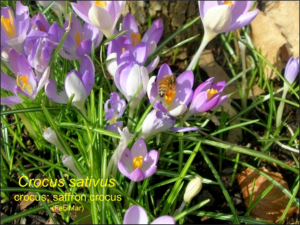 starting to bloom for our girls coming out of the darkness of winter. Also vine plants such as the winter jasmine and winter honeysuckle are beginning to bloom as well. For a more detailed report on current flowering plants check out Bridgetown Bees for Glen’s monthly “What’s in bloom” report. Click here to check it out. In addition, if you happen to run across any interesting honey bee plants during your outside times be sure to email Glen with any photos and/or suggestions.
starting to bloom for our girls coming out of the darkness of winter. Also vine plants such as the winter jasmine and winter honeysuckle are beginning to bloom as well. For a more detailed report on current flowering plants check out Bridgetown Bees for Glen’s monthly “What’s in bloom” report. Click here to check it out. In addition, if you happen to run across any interesting honey bee plants during your outside times be sure to email Glen with any photos and/or suggestions.
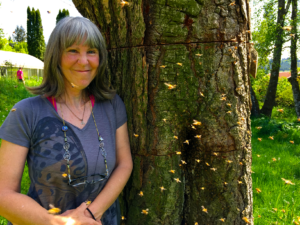 Our featured speaker this month was Susan Chernak McElroy, best-selling author, master storyteller and co-founder of Spirit Bee. Susan’s hives are the focus of her spiritual practice—the apiary as temple, teacher, divine inspiration, and meditation corner. She continues to study the science and the mystery of beekeeping, and believes that what is truly good for honeybees is equally good for human bee-ings. If you haven’t checked out her New York Times Bestseller, ‘Animals as Teachers and Healers,’ you should. Click here for a link to her books. Susan’s writings are published in more than twenty languages worldwide. Many thanks to Susan for sharing her holistic view of what beekeeping is like for her.
Our featured speaker this month was Susan Chernak McElroy, best-selling author, master storyteller and co-founder of Spirit Bee. Susan’s hives are the focus of her spiritual practice—the apiary as temple, teacher, divine inspiration, and meditation corner. She continues to study the science and the mystery of beekeeping, and believes that what is truly good for honeybees is equally good for human bee-ings. If you haven’t checked out her New York Times Bestseller, ‘Animals as Teachers and Healers,’ you should. Click here for a link to her books. Susan’s writings are published in more than twenty languages worldwide. Many thanks to Susan for sharing her holistic view of what beekeeping is like for her.
We’re excited to announce that Michael Thiele, founder of Gaia Bees will be speaking here in Portland on Saturday, March 18th. More details to come!!
Bee School 2017 was a huge success as we had a record 42 attendees and 8 volunteers. For those not familiar, Bee 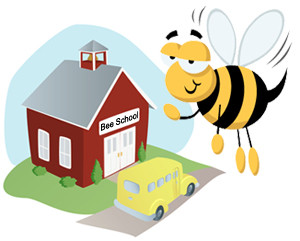 School is a yearly event for beginning beekeepers and provides 6 hours of classroom instruction plus 2 hours of hands on experience inside a working hive. For those who attended, keep on the lookout for your field reminder which will be coming to you in the coming weeks.
School is a yearly event for beginning beekeepers and provides 6 hours of classroom instruction plus 2 hours of hands on experience inside a working hive. For those who attended, keep on the lookout for your field reminder which will be coming to you in the coming weeks.
 At our January 2017 meeting our featured speaker was Andony Melathopoulos.
At our January 2017 meeting our featured speaker was Andony Melathopoulos.
Andony is an Assistant Professor of Pollinator Health Extension in the Department of Horticulture at Oregon State University. His work at OSU comes out of a mandate from the Oregon Legislature to create a state-wide pollinator safety and outreach program. Prior to coming to OSU he was a Postdoctoral Scholar in the Department of Biology at the University of Calgary working with Shelley Hoover and Ralph Cartar on canola pollination. He holds an Interdisciplinary PhD from Dalhousie University (2015) and a Master of Pest Management from Simon Fraser University (1999). Formerly he worked as the chief technician in Agriculture and Agri-Food Canada’s Apiculture Research program (2000-2012).
If the video on Slide 9 doesn’t play it’s linked below:
In this month’s Beeline we will be recapping our October 5th PUB meeting. Our next meeting on Wednesday, November 7th will be at our NEW LOCATION – Rose City Park United Methodist Church located at 5830 NE Alameda St. Click here for directions. DO NOT meet at Alberta Abbey.
This coming Wednesday is our annual PUB Showcase! This will be an opportunity for all PUB members to show off your bee-related projects, plans, products, and employment. Whether you make a living, supplement your income, or just have fun with bees, you are invited to set up a table to show off what you enjoy doing. Spaces are free and tables will be provided. Please email us to reserve your table. Please show up at 6pm to set up your table.
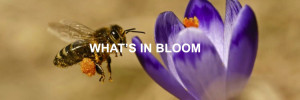 Once again, and in supreme style, Bridgetown Bees’ Glen Andresen shared his monthly Pollen & Nectar report with his extensive slideshow on current flowering plants. As he does each month, Glen provides information on the many blooming nectar and pollen plants still out there that are keeping our girls busy through November/December. For a more detailed report check out Bridgetown Bees for Glen’s monthly “What’s in bloom” report. If you run across any interesting honey bee plants be sure to email Glen with any photos and/or suggestions.
Once again, and in supreme style, Bridgetown Bees’ Glen Andresen shared his monthly Pollen & Nectar report with his extensive slideshow on current flowering plants. As he does each month, Glen provides information on the many blooming nectar and pollen plants still out there that are keeping our girls busy through November/December. For a more detailed report check out Bridgetown Bees for Glen’s monthly “What’s in bloom” report. If you run across any interesting honey bee plants be sure to email Glen with any photos and/or suggestions.
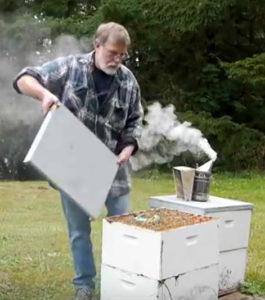 Our featured speaker this month was Mark Johnson. Mark is a former Vice President of OSBA and veteran of 44 years as a commercial beekeeper. Mark, who has over 1200 hives, provides pollination services to farmers starting with the California almond bloom in February, moving from crop to crop all spring and summer, until the time when he harvests honey in August. Honey harvesting is one of the more expense processes a beekeeper does and Mark shared which processes work best for him. “We do both pollination and honey, but honey is only about 20 percent. In western Oregon if you tried to keep bees for honey you’d go broke, it’s mainly renting hives to farmers.” Many thanks to Mark for sharing his big-picture view of what beekeeping is like for him, his family, and employees throughout the year.
Our featured speaker this month was Mark Johnson. Mark is a former Vice President of OSBA and veteran of 44 years as a commercial beekeeper. Mark, who has over 1200 hives, provides pollination services to farmers starting with the California almond bloom in February, moving from crop to crop all spring and summer, until the time when he harvests honey in August. Honey harvesting is one of the more expense processes a beekeeper does and Mark shared which processes work best for him. “We do both pollination and honey, but honey is only about 20 percent. In western Oregon if you tried to keep bees for honey you’d go broke, it’s mainly renting hives to farmers.” Many thanks to Mark for sharing his big-picture view of what beekeeping is like for him, his family, and employees throughout the year.
Congratulations go out to Michael Carlson and Lil Reitzel who won the OSBA conference giveaway. We hope to post their experiences of the conference to our PUB Blog and Facebook page in the coming weeks. Stay tuned!
 PUB Bee School is scheduled for Saturday, January 28th, 2017. If you or a friend have been wanting to take a beginning beekeeping course registration is now open. Click here for more info and to register.
PUB Bee School is scheduled for Saturday, January 28th, 2017. If you or a friend have been wanting to take a beginning beekeeping course registration is now open. Click here for more info and to register.Here’s the repository of presentations given at the meeting this month. Glen’s Pollen & Nectar Report is available at the Bridgetown Bees website.
Dewey Caron gave us a presentation on what to do in the apiary in September.
Dewey mentioned the survey analysis and the “mystery” in his presentation. That analysis is available in the files section of our website. And since Dewey will not be able to attend our October meeting, he put together a document outlining 10 things we can do now to help our bees survive winter.
Our main speaker was Harry Vanderpool, president of OSBA, speaking about overwintering nucs.
July 25, 2016
Write-up and photos by Charlie Vanden Heuvel
Additional contributions by Linda Zahl
Summary: Portland Urban Beekeepers (PUB) hosted a delegation of enthusiastic, Iraqi Young Leaders Exchange Program students at the Portland Urban Beekeeping (PUB) treatment-free apiary located at Zenger Farm, SE Portland, OR, a sustainable, educational, urban farm. The delegation’s U.S. visit was financed by the U.S. Department of State arranged by the World Affairs Council of Oregon. Following a short presentation about bees, moved to a hands-on experience with beekeeping practices, and finally to tasting honey. The PUB beekeepers demonstrating honey bee care and health management were: Linda Zahl the PUB Board Member, Education Coordinator, Journey Level Oregon Master Beekeeping Program; Susie Wilcox, PUB Member; Charlie Vanden Heuvel, PUB Member, Journey Level Oregon Master Beekeeping Program; Annette Carter, PUB Member, Frank Gransha, Professor Geology Portland State University, PUB Member; Lily Glaeser, Botanist, presenter of The Honey Bee and Beekeeping, PUB Member; Micah Hamley, PUB Member; Luca, (teenager) PUB Member
This is the second year that the World Affairs Council of Oregon asked Portland Urban Beekeepers (PUB) to host a delegation from the middle east. Last year we hosted a group of Government Agricultural Agents from Afghanistan and we felt it an honor to contribute toward their understanding of American honey bee management practices. This year, when approached by the Council to host a group of teenagers from Iraq, we felt extremely privileged to be able to help the next generation become, if not beekeepers, then young professionals who understand the role of beekeeping in the world.
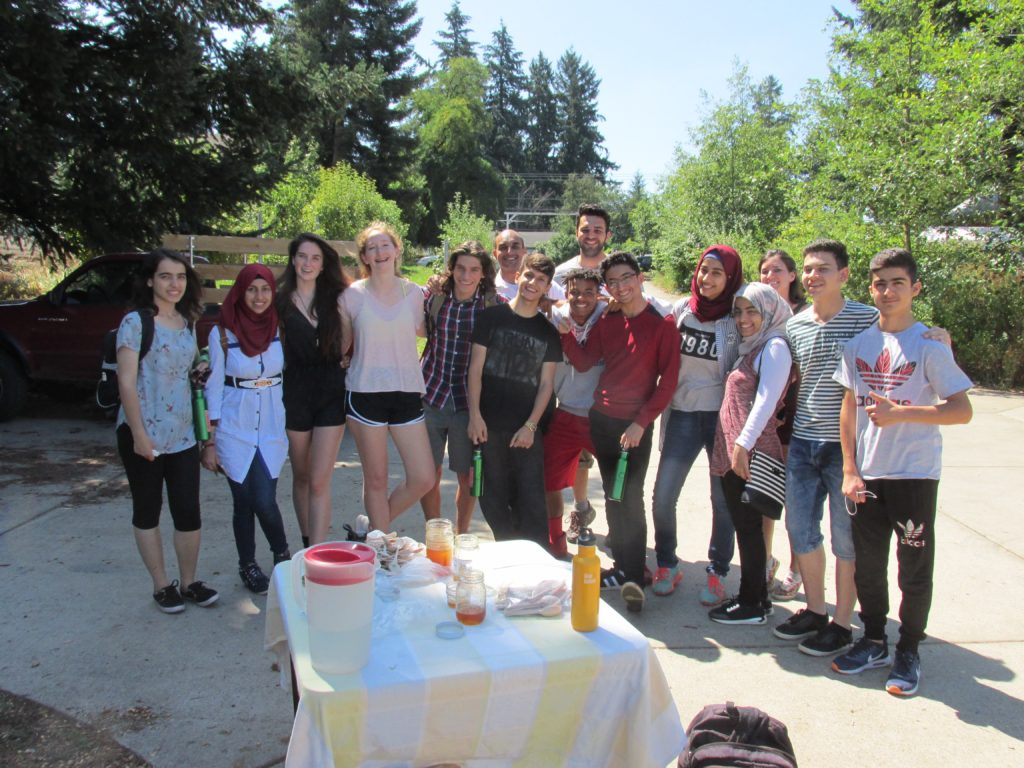
Beekeeping in Iraq has existed for 5,000 years until it was shut down in 1992 (Hartigan, Mahmoud and Michael, USA Today, 2005, Ancient tradition revived to turn honey into money). “The general situation is that conflict over the last decade and a half has devastated the beekeeping industry of Iraq, which at one time was a thriving activity with an estimated half million colonies of honey bees managed by a majority of the rural population.” (Sanford, Dr. Malcolm T., University of Florida)
It is currently being revived, so hosting teenagers from Iraq transcended cultural, theological, and language barriers. One look at the innocence on the faces filled with hope created an atmosphere for these students to experience first-hand apiculture in the U.S.
The Iraqi Young Leaders Exchange Program (IYLEP) is one of the many exchange programs the State Department administers each year to strengthen people-to-people relationships between Iraqis and Americans. It enables Iraqi and U.S. high school students and adult mentors to develop leadership skills and build action plans to strengthen the future of Iraq and the U.S. The students on the IYLEP were introduced to new skills and networks through participation in community service activities and leadership workshops, interactions with U.S. students, and site visits to civic, youth, and governmental organizations. The group was comprised of students from Kurdistan and Iraq.
Throughout the four-week program, the seven Iraqi youth participants were accompanied by seven U.S. high school students and two Iraqi adult mentors. The group spent one week in Vermont, came to Portland Oregon for two weeks to emerge in environmental stewardship and cross-cultural leadership opportunities, and then will move on to Washington D.C.
The moment the group exited the bus at Zenger Farm their faces displayed excitement coupled with a bit of anxiety about meeting the apis mellifera ‘face to face’. Lily Glaeser gathered the group around the apiary for a short discussion on honey bee casts, drone congregation areas, plant pollination, nectar, and of course bee stings.
None of the students had prior apiary experience. Yet the students challenged the PUB presenters with insightful questions throughout the experience dealing with beekeeping management techniques and the honey bee.
PUB Members then broke the students into smaller groups delving into the hives to witness first hand hive activity and frames. Each ‘hive PUB mentor’ turned their hive tool over to the students to enhance their personal experience. The expression of joy was evident as they lifted frames of capped honey, capped brood, pollen, and nectar. Although fully suited, each smelled the hives’ honey and propolis all the while discussing the virtues of their apitherapy qualities. As the treatment of gout with honey is popular in their region it became a topic of discussion (Najafi, Tahereh Eteraf-Oskouel and Moslem) as did honey’s and propolis’s inhibitory effect on bacteria.
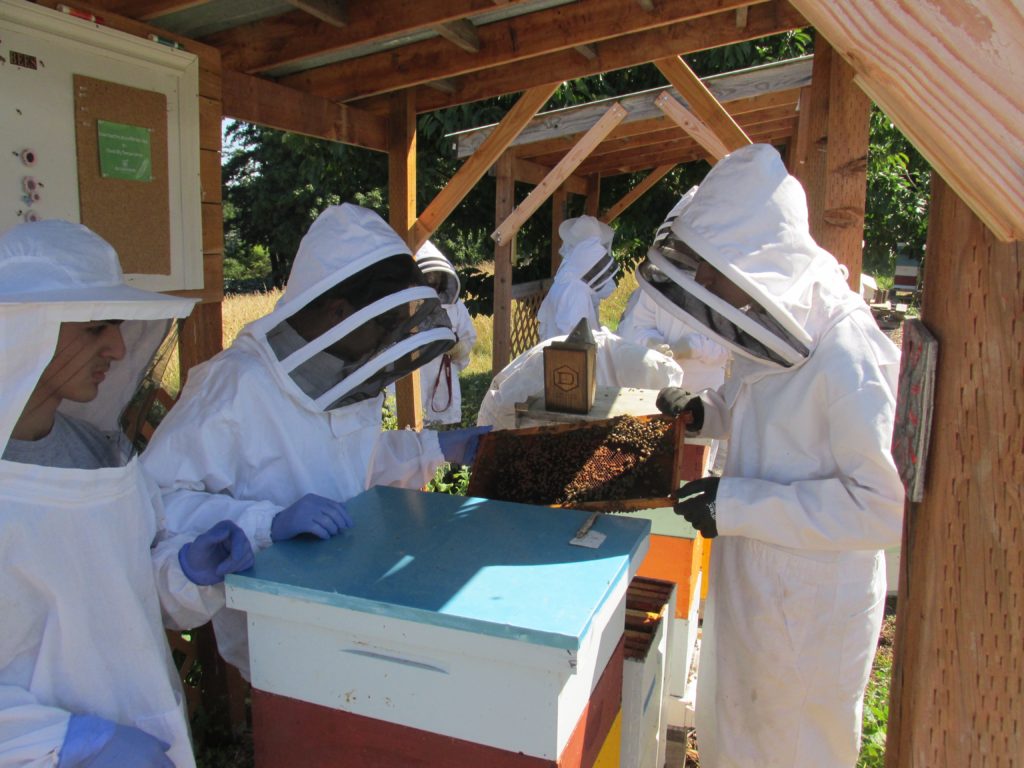
The members began to take covers off Langstroth Hives in search of the queen. Then rapidly moving to the upper box where each handled frames in exploration of the intricacies of hive populations and their interactions. Being August only a few drones were evident, but when found the drone was picked up by the student to have an up close feel. Each PUB mentor brought the hives inner-workings into the personalized time.
One of the hives was experiencing Idiopathic Brood Disease Syndrome (Oregon State University insect ID Clinic, Oregon State University) allowing a great opportunity to visualize hive disease. Iraq’s existing hives, according to a report by Sanders in 2005 have 10% and 40% Varroa mite infestation. Due to time constraints, discussion on treatments of this devastating issues did not transpire.
When one of the students came away from the hive with a dozen of the girls on her finger, it became clear a bond, as we have all acquired, was fermented. Watching each of the group’s zeal as they held up frames, picked up drones, smelled the honey and propolis, and observed the bees on each frame proved the benefit of this occasion.

Some of the group moved on to the Top Bar Hive for a discussion on the differences between it and the Langstroth Hive. While the Langstroth Hives predominately had frames with foundations, in the Top Bar Hive the students witnessed natural comb. This provided an opportunity to discuss the bee’s wax gland and how comb was created.
After the students’ apiary explorations the group moved to a honey tasting table to sample different types of the hives’ gold, donated by PUB members from their local bees. Evidently this proved delightful.
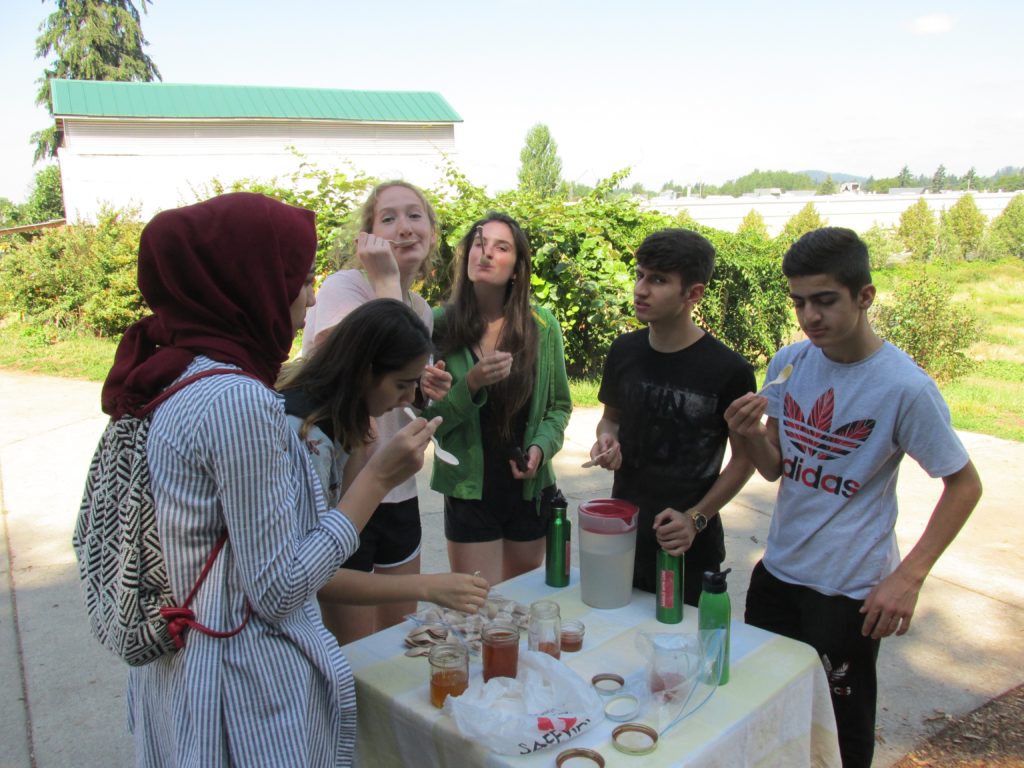
While standing around the table, an open discussion of the morning’s events transpired. “What is swarming?” “How long does it take the hive to recover from a swarm?” “How do queens mate?” And more. This culminating forum was evidence of the impact the morning’s experience was for these eager minds. Allie Collopy, representing World Affairs Council of Oregon, at the end of the morning shared how excited the group was about their activities in the apiary.
Thank you, IYLEP high schoolers, for all that you gave us. And thank you, World Affairs Council of Oregon and the State Department, for making it possible.
References
Hartigan, Mahmoud and Michael, USA Today, Ancient tradition revived to turn honey into money
Sanford, Dr. Malcolm T., University of Florida
Najafi, Tahereh Eteraf-Oskouel and Moslem, Traditional and Modern Uses of Natural Honey in Human Diseases: A Review, National Institutes of Health, US National Library of Medicine
Oregon State University insect ID Clinic, Oregon State University
In this month’s Beeline we will be recapping our August 3rd PUB meeting. Our next meeting is Wednesday, September 7th at Alberta Abbey from 7-9pm. Hope to see you there!
 In supreme fashion, Bridgetown Bees’ Glen Andresen shared his monthly Pollen & Nectar report with his extensive slideshow on current flowering plants. As he does each month, Glen provides information on the many blooming nectar and pollen plants still out there that are keeping our girls busy through October/November. For those hobby farmers with vegetable planters we say thank you! There are many veggies still flowering through November. For a more detailed report check out Bridgetown Bees for Glen’s monthly “What’s in bloom” report. Also email Glen with any photos and/or suggestions of other good honey bee plants.
In supreme fashion, Bridgetown Bees’ Glen Andresen shared his monthly Pollen & Nectar report with his extensive slideshow on current flowering plants. As he does each month, Glen provides information on the many blooming nectar and pollen plants still out there that are keeping our girls busy through October/November. For those hobby farmers with vegetable planters we say thank you! There are many veggies still flowering through November. For a more detailed report check out Bridgetown Bees for Glen’s monthly “What’s in bloom” report. Also email Glen with any photos and/or suggestions of other good honey bee plants.
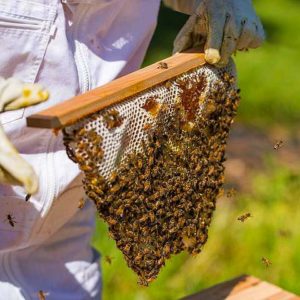 Our featured speaker this month was Andrew Bray, who shared his best tips and tricks for new or experienced top bar beekeepers on how to manage a top bar hive. Also if haven’t taken advantage of Andrew’s 10% off at beethinking.com, now is the time. Head over to Beethinking.com and use coupon code BEEANDREWB. In addition, Andrew will be teaching an Intermediate Beekeeping Class, as well as a Winterizing Your Hive Class, in case you’re interested! Head over to http://www.beethinking.com/collections/classes for more info on the classes.
Our featured speaker this month was Andrew Bray, who shared his best tips and tricks for new or experienced top bar beekeepers on how to manage a top bar hive. Also if haven’t taken advantage of Andrew’s 10% off at beethinking.com, now is the time. Head over to Beethinking.com and use coupon code BEEANDREWB. In addition, Andrew will be teaching an Intermediate Beekeeping Class, as well as a Winterizing Your Hive Class, in case you’re interested! Head over to http://www.beethinking.com/collections/classes for more info on the classes.
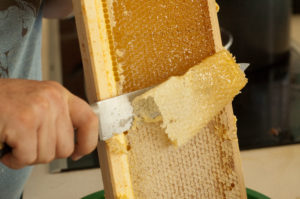 Honey Harvest parties are going on August 21st and September 18th at Zenger farm. Contact Lauren Smith to sign- up for a time slot. Time-slots are 2 hours each between 8am & 4pm. You get 1-1/2 hours to extract plus 30 minutes to clean up and prep for the next person. Final clean up begins at 4pm. Please don’t bring more than 2 supers, as you may not have time to finish more than that. Please bring your own honey buckets. Empty pint jars can be purchased from PUB during the party at $1.00/jar.
Honey Harvest parties are going on August 21st and September 18th at Zenger farm. Contact Lauren Smith to sign- up for a time slot. Time-slots are 2 hours each between 8am & 4pm. You get 1-1/2 hours to extract plus 30 minutes to clean up and prep for the next person. Final clean up begins at 4pm. Please don’t bring more than 2 supers, as you may not have time to finish more than that. Please bring your own honey buckets. Empty pint jars can be purchased from PUB during the party at $1.00/jar.
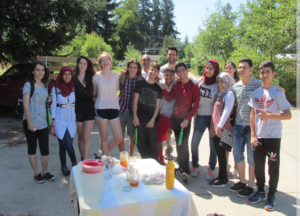 Finally, PUB was extremely proud to host a delegation of enthusiastic, Iraqi Young Leaders Exchange Program students at our treatment-free apiary located at Zenger Farm. The delegation’s U.S. visit was financed by the U.S. Department of State arranged by the World Affairs Council of Oregon. Following a short presentation about bees, moved to a hands-on experience with beekeeping practices, and finally to tasting honey. The PUB beekeepers demonstrating honey bee care and health management were: Linda Zahl the PUB Board Member, Education Coordinator, Journey Level Oregon Master Beekeeping Program; Susie Wilcox, PUB Member; Charlie Vanden Heuvel, PUB Member, Journey Level Oregon Master Beekeeping Program; Annette Carter, PUB Member, Frank Gransha, Professor Geology Portland State University, PUB Member; Lilly Glaeser, Botonist, presenter of The Honey Bee and Beekeeping, PUB Member; Micah Hamley, PUB Member; Luca, (teenager) PUB Member.
Finally, PUB was extremely proud to host a delegation of enthusiastic, Iraqi Young Leaders Exchange Program students at our treatment-free apiary located at Zenger Farm. The delegation’s U.S. visit was financed by the U.S. Department of State arranged by the World Affairs Council of Oregon. Following a short presentation about bees, moved to a hands-on experience with beekeeping practices, and finally to tasting honey. The PUB beekeepers demonstrating honey bee care and health management were: Linda Zahl the PUB Board Member, Education Coordinator, Journey Level Oregon Master Beekeeping Program; Susie Wilcox, PUB Member; Charlie Vanden Heuvel, PUB Member, Journey Level Oregon Master Beekeeping Program; Annette Carter, PUB Member, Frank Gransha, Professor Geology Portland State University, PUB Member; Lilly Glaeser, Botonist, presenter of The Honey Bee and Beekeeping, PUB Member; Micah Hamley, PUB Member; Luca, (teenager) PUB Member.
Curious about which Varroa treatments are most effective? Here’s an update from OSU on the research they’ve been conducting:
This document and several other helpful resources are available on our club Resources page.
In this month’s Beeline we will be recapping our July 6th PUB meeting. Our next meeting is Wednesday, August 3rd at Alberta Abbey from 7-9pm. Hope to see you there!
 As always, a huge thanks goes out to Glen Andresen for sharing his monthly Pollen & Nectar report. Alas, as the end of blackberry season is upon us, we also see the end of the honey flow. But there are plenty of blooming nectar and pollen plants still out there that are keeping our girls busy through October/November. For example, Scabiosa (also called the pincushion flower) will keep flowing and blooming on through November. For a more detailed report check out Bridgetown Bees for Glen’s monthly “What’s in bloom” report. Also email Glen with any photos and/or suggestions of other good honey bee plants.
As always, a huge thanks goes out to Glen Andresen for sharing his monthly Pollen & Nectar report. Alas, as the end of blackberry season is upon us, we also see the end of the honey flow. But there are plenty of blooming nectar and pollen plants still out there that are keeping our girls busy through October/November. For example, Scabiosa (also called the pincushion flower) will keep flowing and blooming on through November. For a more detailed report check out Bridgetown Bees for Glen’s monthly “What’s in bloom” report. Also email Glen with any photos and/or suggestions of other good honey bee plants.
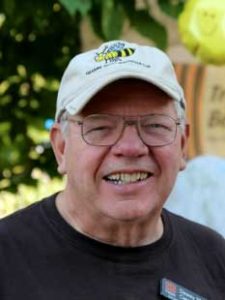 We heard once again from Dr. Dewey Caron as he shared this year’s results for the PNW Honey Bee Survey. He also shared best practices for mite control. This is something that all beekeepers must do to keep their hives healthy. His presentation outlined three basic methods for monitoring mites which included the natural mite drop and the popular sugar shake method. Click here to download a PDF and choose a method for your own hives. Again this is an essential step in maintaining your hives to give them the best chance to survive winter.
We heard once again from Dr. Dewey Caron as he shared this year’s results for the PNW Honey Bee Survey. He also shared best practices for mite control. This is something that all beekeepers must do to keep their hives healthy. His presentation outlined three basic methods for monitoring mites which included the natural mite drop and the popular sugar shake method. Click here to download a PDF and choose a method for your own hives. Again this is an essential step in maintaining your hives to give them the best chance to survive winter.
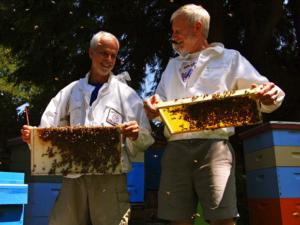 We also heard from Tim Wessels and Glen Andresen, co-owners of Bridgetown Bees. In addition to providing honey and beekeeping equipment at their brick-and-mortar store, the primary mission of Bridgetown Bees is to selectively breed and raise queen bees in the city of Portland that are suitable for year-round survival here and in other cities in the Pacific Northwest. Tim and Glen shared an informative presentation for their queen raising methods. If you have any questions for Tim or Glen on their methods give them a email at contactusbridgetownbees(at)gmail.com.
We also heard from Tim Wessels and Glen Andresen, co-owners of Bridgetown Bees. In addition to providing honey and beekeeping equipment at their brick-and-mortar store, the primary mission of Bridgetown Bees is to selectively breed and raise queen bees in the city of Portland that are suitable for year-round survival here and in other cities in the Pacific Northwest. Tim and Glen shared an informative presentation for their queen raising methods. If you have any questions for Tim or Glen on their methods give them a email at contactusbridgetownbees(at)gmail.com.
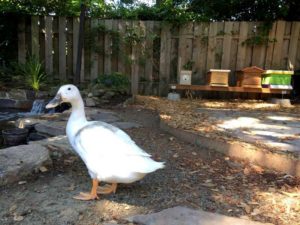 Tour De Hives 2016 was a smash success with our largest turnout yet! Thanks to all the volunteers, hosts and people behind the scenes that made it happen. Check out the Photo Gallery. Also if you haven’t filled out the Tour De Hives survey it would help us make next year’s event even better. It takes only 3 minutes. Thanks!
Tour De Hives 2016 was a smash success with our largest turnout yet! Thanks to all the volunteers, hosts and people behind the scenes that made it happen. Check out the Photo Gallery. Also if you haven’t filled out the Tour De Hives survey it would help us make next year’s event even better. It takes only 3 minutes. Thanks!
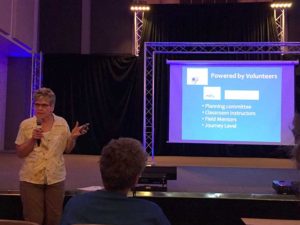 Rita Ostrofsky started things off with an overview of the Oregon Master Beekeepers program. The OMB program is celebrating it’s 5th year and is a cooperative effort between Oregon State University and the Oregon State Beekeepers Association.
Rita Ostrofsky started things off with an overview of the Oregon Master Beekeepers program. The OMB program is celebrating it’s 5th year and is a cooperative effort between Oregon State University and the Oregon State Beekeepers Association. Glen Andresen shared his monthly Pollen & Nectar report. Glen took us through annuals, perennials, shrubs, vines and flowering trees that are contributing to this year’s record honey flow. For a more detailed report check out bridgetownbees.com for Glen’s monthly “What’s in bloom” report. And please email Glen with any photos and/or suggestions of other good honey bee plants.
Glen Andresen shared his monthly Pollen & Nectar report. Glen took us through annuals, perennials, shrubs, vines and flowering trees that are contributing to this year’s record honey flow. For a more detailed report check out bridgetownbees.com for Glen’s monthly “What’s in bloom” report. And please email Glen with any photos and/or suggestions of other good honey bee plants.
Our featured speaker was Washington State Master Beekeeper Morris Ostrofsky, who explored best practices for varroa mite control. Morris’ passion for teaching 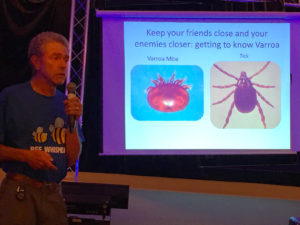 and beekeeping becomes apparent when he shares his knowledge with others. An interest in genetics and queen rearing has led to a quest to breed locally adapted, treatment free bees using the Miller Method. Below is his presentation.
and beekeeping becomes apparent when he shares his knowledge with others. An interest in genetics and queen rearing has led to a quest to breed locally adapted, treatment free bees using the Miller Method. Below is his presentation.
Tuesday’s PUB booth at Pioneer Courthouse Square had a great turnout of both PUB members and public visitors. 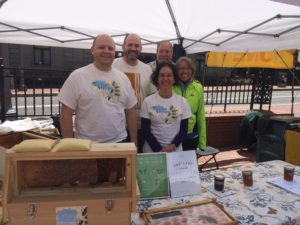 The weather cooperated 90% of the time and lots of people were out and about during the lunch hour, stopping by and learning about bees and Tour de Hives.
The weather cooperated 90% of the time and lots of people were out and about during the lunch hour, stopping by and learning about bees and Tour de Hives.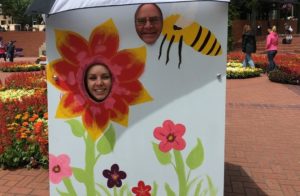
We’re less than 10 days from Tour De Hives 2016 which is the weekend of June 25-26! This is our yearly fundraiser and PUB’s best opportunity to introduce Portlanders to the art and science of beekeeping. Tickets now on sale here so please spread the word to all your friends.